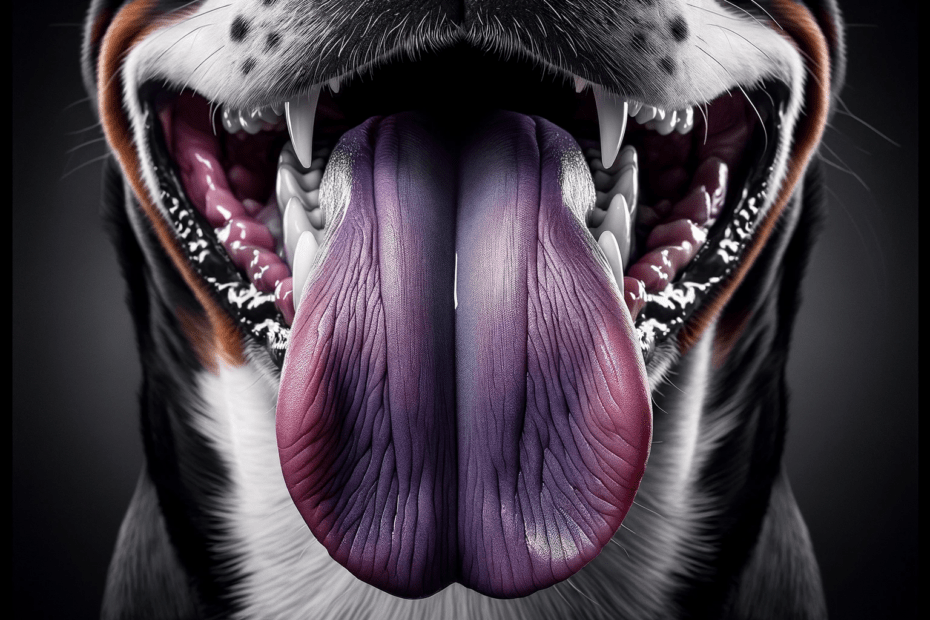Discover the intriguing world of canine tongues with our informative article on ‘What Dogs Have Purple Tongues.’
Delve into the genetic factors and inherited traits that contribute to this distinctive tongue color, as well as the specific breeds known for their unique pigmentation.
We will also explore the role of melanin production and its impact on tongue color, along with potential health conditions associated with purple tongues in dogs.
Stay tuned for valuable tips on maintaining your dog’s tongue health and vibrancy.
Key Takeaways
- Genetic factors contribute to dogs having purple tongues.
- Chow Chow and Shar-Pei are breeds known for their distinctive purple tongues.
- The genetic mutation causing purple tongues in these breeds is purely cosmetic and has no detrimental effects on their health.
- A purple tongue in dogs may indicate underlying health issues and require veterinary attention.
Genetic Factors: Inherited Traits That Cause Purple Tongues in Dogs
One of the key factors that contribute to dogs having purple tongues is the presence of inherited traits, which are influenced by genetic factors. Genetic mutations play a significant role in determining the color of a dog’s tongue. These mutations can result in the production of excess pigment called melanin, which gives the tongue its purple hue.
Environmental factors can also influence the expression of these genetic traits. For example, certain foods or medications may interact with the dog’s genetic makeup and cause changes in tongue color. Additionally, exposure to extreme temperatures or environmental toxins can affect the pigmentation of the tongue.
It’s important to note that not all dogs with purple tongues have inherited this trait. Some breeds, such as the Chow Chow and the Shar-Pei, are more likely to have purple tongues due to their genetic makeup. In these cases, the presence of a purple tongue is a breed characteristic rather than a result of genetic mutations.
Understanding the genetic and environmental factors that contribute to dogs having purple tongues can help veterinarians and researchers better comprehend the underlying mechanisms involved. Further studies are needed to explore the specific genetic mutations and environmental triggers that lead to tongue discoloration in dogs.
Breeds With Purple Tongues: Dog Breeds Known for Their Distinctive Tongue Color
Breeds such as the Chow Chow and the Shar-Pei are known for their distinctive purple tongues. This unique characteristic is the result of genetic mutations that affect the production of pigments in the tongue. While most dogs have tongues that range from pink to black, these specific breeds have tongues that appear purple or bluish-black.
The Chow Chow, with its ancient origins in China, is often associated with its purple tongue. This breed has a thick double coat and a distinctive blue-black tongue, which adds to its regal appearance. Similarly, the Shar-Pei, also originating from China, is recognized for its deep purple tongue.
The genetic mutation that causes the purple tongue in these breeds does not have any detrimental effects on their health. In fact, it is purely a cosmetic characteristic.
Interestingly, the cultural significance of dogs with purple tongues varies across different societies. In Chinese culture, the purple tongue is considered a sign of good luck and prosperity. Some legends even suggest that the Chow Chow’s tongue turned purple after it licked the sky to bring good fortune.
Melanin and Tongue Color: How Melanin Production Affects Tongue Pigmentation
The production of melanin plays a crucial role in determining the pigmentation of a dog’s tongue, as discussed in the previous subtopic on breeds with purple tongues. Melanin is a pigment that is responsible for the coloration of various body parts, including the skin, hair, and eyes. In the case of a dog’s tongue, the presence of melanin can result in a purple hue.
Melanin and tongue pigmentation are not just a matter of appearance. The amount of melanin in a dog’s tongue can actually have implications for their overall health. Melanin acts as a natural sunscreen, protecting the tongue from harmful ultraviolet (UV) radiation. This is particularly important for dogs with lighter skin tones, as they are more susceptible to sunburn and other sun-related issues.
Furthermore, the color of a dog’s tongue can also affect their overall appearance. A vibrant, healthy-looking tongue can be an indicator of good overall health. Conversely, a pale or discolored tongue may suggest underlying health issues that require attention.
Health Conditions: Medical Conditions Associated With Purple Tongues in Dogs
Medical conditions that can be associated with dogs having purple tongues are important to understand for the health and well-being of these animals.
While tongue pigmentation can vary among different dog breeds, a purple tongue is not a normal color and may indicate an underlying health issue.
One possible cause of a purple tongue in dogs is a genetic disorder called Black Tongue Syndrome. This condition affects certain breeds, such as Chow Chows and Shar-Peis, and is characterized by the darkening of the tongue, which can appear purple.
Another medical condition that can lead to a purple tongue in dogs is cyanosis. Cyanosis occurs when there is a lack of oxygen in the bloodstream, causing the tongue and other mucous membranes to turn bluish-purple. This can be a sign of an underlying respiratory or circulatory problem and requires immediate veterinary attention.
It is important for dog owners to be aware of these potential health conditions associated with purple tongues in dogs and to seek veterinary care if their dog’s tongue color changes. Early detection and treatment can help ensure the best possible outcome for the dog’s overall health and well-being.
Tongue Discoloration in Puppies: Why Some Puppies Have Purple Tongues
Tongue discoloration in puppies, specifically the presence of purple tongues, can be attributed to various factors. One possible cause of purple tongues in puppies is genetic factors. Some dog breeds, such as Chow Chows and Shar-Peis, are genetically predisposed to having purple tongues. This pigmentation is usually harmless and does not indicate any underlying health conditions.
However, in some cases, tongue discoloration in puppies may be a sign of certain health conditions. For example, cyanosis, which is characterized by a bluish-purple coloration of the tongue, can be a symptom of respiratory or circulatory problems. If a puppy’s tongue appears consistently purple and is accompanied by other concerning symptoms like difficulty breathing or lethargy, it would be wise to consult a veterinarian for a proper diagnosis and treatment.
It is important to note that tongue discoloration alone is not enough to determine a puppy’s health status. Other factors, such as the puppy’s overall behavior, appetite, and physical appearance, should also be considered. Regular veterinary check-ups and open communication with a trusted veterinarian can help ensure the well-being of your puppy.
Other Tongue Colors: Exploring Different Tongue Colors in Dogs
When considering the range of tongue colors in dogs, it is important to explore various pigmentation variations beyond the presence of purple tongues. While purple tongues are a unique characteristic found in certain breeds, such as the Chow Chow and the Shar-Pei, there are other tongue colors that can be observed in dogs. These colors can range from blue to black, pink, or even spotted.
The color of a dog’s tongue is determined by a combination of genetic mutations and environmental factors. Genetic mutations can lead to variations in pigmentation, resulting in tongues that are different colors from the typical pink. For example, a blue tongue in dogs is caused by genetic variations that affect the production of pigments.
Environmental factors can also play a role in the coloration of a dog’s tongue. Exposure to certain substances or conditions can cause temporary discoloration. For instance, excessive licking of a particular substance like food coloring may temporarily change the color of the tongue.
Tongue Examination: How to Check Your Dog’s Tongue for Any Abnormalities
When examining your dog’s tongue, it is important to pay attention to any color abnormalities as they can be indicators of oral health issues. A healthy dog’s tongue should typically be pink in color, but variations can occur.
If you notice any unusual colors, such as a purple tongue, it is recommended to consult with your veterinarian to determine the cause and appropriate course of action.
Color Abnormalities in Tongues
Examining the color of a dog’s tongue can provide valuable insights into potential abnormalities. While a normal dog’s tongue is typically pink, color abnormalities can occur due to various factors.
Genetic mutations can sometimes lead to pigmentation changes in a dog’s tongue, resulting in colors such as blue, purple, or black. These mutations are often harmless and purely cosmetic.
On the other hand, certain environmental factors can also play a role in tongue discoloration. For example, exposure to certain chemicals or toxins can cause the tongue to become discolored or develop lesions.
It is important for dog owners to regularly examine their pet’s tongue for any color abnormalities, as this can be an indication of underlying health issues that may require veterinary attention.
Indicators of Oral Health
To assess your dog’s oral health, a thorough examination of their tongue is essential, as it can reveal any abnormalities or potential health issues.
The color of your dog’s tongue can provide valuable information about their overall health. While some genetic mutations can cause variations in tongue color, such as the presence of purple spots or patches, these are rare.
More commonly, changes in tongue color can be attributed to other factors, such as diet. For example, a dog with an iron deficiency may have a pale or whitish tongue, while a dog with liver disease may have a yellowish tint.
Therefore, it is important to observe your dog’s tongue regularly and consult a veterinarian if you notice any significant changes in color or texture.
Care and Maintenance: Tips for Keeping Your Dog’s Tongue Healthy and Vibrant
To ensure your dog’s tongue remains healthy and vibrant, it is important to focus on preventing tongue discoloration and maintaining good oral hygiene.
Regular brushing, using dog-friendly toothpaste, can help remove plaque and prevent the buildup of bacteria that can cause discoloration.
Additionally, providing your dog with appropriate chew toys and treats can help keep their tongue and teeth clean.
Preventing Tongue Discoloration
Maintaining proper care and hygiene is essential for preserving the vibrant color and health of your dog’s tongue. Preventing tongue discoloration and maintaining oral hygiene are key factors.
Regular brushing of your dog’s teeth is crucial to remove plaque and tartar buildup, which can contribute to tongue discoloration. Use a dog-friendly toothbrush and toothpaste recommended by your veterinarian.
Additionally, providing your dog with appropriate chewing toys and treats can help promote good oral health and prevent tongue discoloration. These toys and treats can help remove bacteria and food particles from the tongue, reducing the risk of discoloration.
Regular visits to the veterinarian for dental check-ups and professional cleanings are also important for maintaining your dog’s oral health and preventing tongue discoloration.
Importance of Oral Hygiene
Proper oral hygiene is crucial for maintaining the health and vibrancy of your dog’s tongue. While genetic inheritance plays a role in determining tongue pigmentation, it is essential to take care of your dog’s oral health to ensure a healthy and vibrant tongue.
Regular brushing of your dog’s teeth and tongue is the first step in maintaining good oral hygiene. This helps to remove plaque and bacteria buildup, preventing tongue discoloration and potential health issues.
Additionally, providing your dog with proper dental care, such as regular dental check-ups and professional cleanings, can further promote a healthy tongue.
Frequently Asked Questions
Can a Dog Have a Purple Tongue and Not Have Any Health Conditions?
A dog can have a purple tongue without having any health conditions.
Dog tongue discoloration, such as a purple hue, can occur due to various causes. Some dogs naturally have pigmented tongues, which may be genetic or breed-specific. Other factors that can contribute to a purple tongue include bruising, inflammation, or exposure to certain substances.
It is important to consult a veterinarian if you notice any changes in your dog’s tongue color to rule out any underlying health issues.
Are There Any Specific Dog Breeds That Have Purple Tongues?
Dog breeds with purple tongues are a result of genetic factors, rather than a specific breed. The color of a dog’s tongue is determined by the amount of pigmentation in its cells.
While some breeds, such as Chow Chows and Shar-Peis, are more commonly associated with purple tongues, it is not exclusive to them. Other factors, such as age and individual variation, can also influence tongue color.
It is important to note that a purple tongue does not necessarily indicate any health conditions in dogs.
Can the Color of a Dog’s Tongue Change Over Time?
Yes, the color of a dog’s tongue can change over time. Various factors such as diet, environmental exposure, and certain health conditions can affect the color of a dog’s tongue.
For example, a dog’s tongue may become darker or develop spots due to pigmentation changes caused by melanin production. Additionally, certain health conditions like cyanosis or lack of oxygenation can cause discoloration.
It is important to monitor any changes in a dog’s tongue color and consult a veterinarian if necessary.
Is It Possible for a Dog to Have a Partially Purple Tongue?
A dog’s tongue color can be an indicator of their overall health. While it is possible for a dog to have a partially purple tongue, it is important to consider various factors before drawing conclusions.
The color of a dog’s tongue can change due to environmental factors such as exposure to extreme temperatures or certain foods. However, it is recommended to consult a veterinarian if there are concerns about a dog’s tongue color, as it could also be a sign of underlying health issues.
What Can I Do to Maintain My Dog’s Tongue Health and Prevent Discoloration?
To maintain your dog’s tongue health and prevent discoloration, there are several ways you can ensure their well-being.
Providing a balanced and nutritious diet is essential, as deficiencies in certain nutrients can lead to discoloration.
Regular dental care, including brushing their teeth and providing dental chews, can help prevent oral health issues that may affect the appearance of the tongue.
Additionally, regular check-ups with a veterinarian can help identify and address any underlying health conditions that may be causing tongue discoloration.
Conclusion
In conclusion, the presence of purple tongues in dogs can be attributed to:
- Genetic factors
- Specific dog breeds
- Melanin production
- Certain health conditions
- Tongue discoloration in puppies
While purple tongues are not necessarily a cause for concern, it is important to regularly examine your dog’s tongue for any abnormalities.
Proper care and maintenance, including regular veterinary check-ups, can help ensure your dog’s tongue remains healthy and vibrant.






